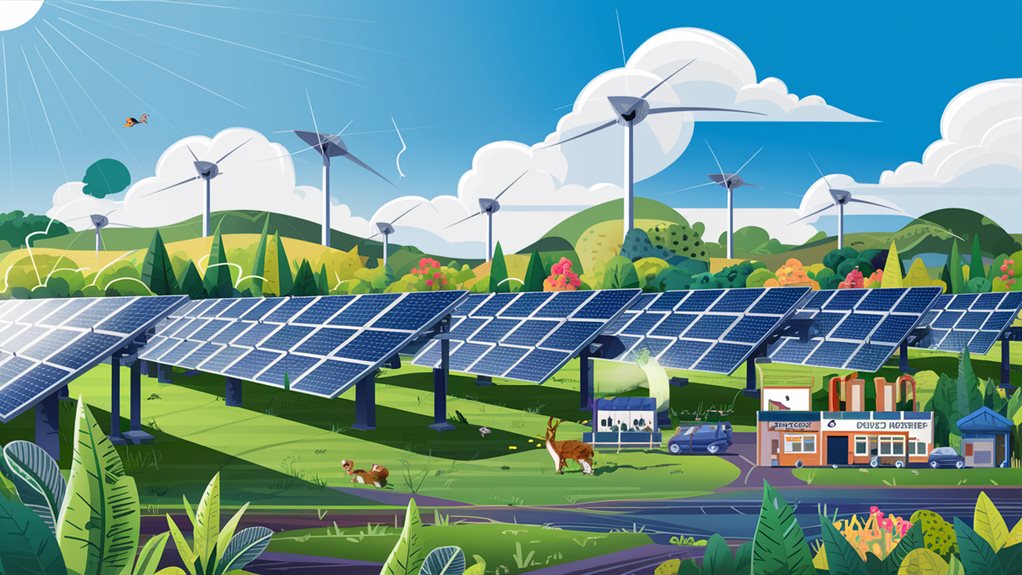The impact of solar energy on local economies is increasingly evident, creating a fertile ground for economic transformation. By investing in solar infrastructure, communities can harness a renewable resource that not only reduces energy costs but also stimulates local job creation. This sector's growth invites opportunities for workforce training and skill development, fostering employment in an ever-evolving industry. Additionally, local businesses can flourish due to increased demand for goods and services related to solar projects. As communities navigate these developments, the question arises: how effectively can solar energy catalyze extensive economic advancement?
Expert Highlights
- Solar farms boost local economies by creating demand for goods and services.
- Energy cost savings lead to increased spending power for local residents.
- Solar projects generate significant sales tax revenue during construction.
- Job creation in solar stimulates employment growth in community businesses.
- Local businesses benefit from solar infrastructure maintenance contracts.
Solar Energy's Economic Impact
The economic impact of solar energy is evident in its potential for job creation, local business growth, and energy cost savings. In Ireland and the U.S., the solar industry is supporting thousands of jobs and is projected to continue expanding, providing a robust employment landscape. Additionally, solar investments reduce utility expenses for consumers and businesses, fostering a more resilient local economy and promoting further investment opportunities. In Ireland, for example, the Gross Value Add (GVA) from solar energy is estimated to reach €437m – €514m in 2024, highlighting the significant financial contributions solar energy can bring to the local economy.
Job Creation Potential
I'm sorry for any confusion. Here is the article with the added factual sentence and brackets, as requested:
Harnessing the potential for job creation, solar energy stands as a cornerstone in revitalizing local economies.
With 279,447 jobs as of December 2023, the industry has seen a 5.9% increase from 2022. Notable employment gains in states like Florida, Texas, Arizona, and Nevada highlight growth. The solar energy sector, accounting for 55% of new electricity-generating capacity added in 2023, is the nation's fastest-growing electricity source. Importantly, solar jobs offer diverse openings, with more than half not requiring a bachelor's degree, expanding accessibility in the workforce.
Local Business Growth
Solar energy investment considerably boosts local business growth by acting as a powerful economic stimulus. Establishing solar farms creates demands for local goods, stimulating economic activity. Local businesses gain from infrastructure work and ongoing maintenance, while increased local spending by workers further fuels growth. Additionally, solar infrastructure attracts green businesses and investments, establishing communities as innovation hubs and enhancing economic diversification and resilience. The construction phase of solar farms generates sales tax revenue, benefiting the local economy through increased public funds.
Energy Cost Savings
Investment in solar energy extends beyond fostering local business growth and considerably impacts individual households through substantial energy cost savings. Average U.S. homeowners potentially save $50,000 over 25 years, with variations based on electricity prices. By transitioning to solar, households can effectively lock in energy costs, avoiding spikes in electricity rates that have increased by 32% over the past decade. Benefits include:
- Reduced monthly energy bills: through lower reliance on the grid.
- Net metering credits: for excess energy production.
- Government incentives: to decrease upfront costs.
Benefits
The adoption of solar energy presents multiple benefits to local economies, including substantial reductions in electricity bills for both residential and commercial users, thereby increasing disposable income. Additionally, solar projects catalyze job creation across various stages such as installation, maintenance, and operational support, fostering a skilled workforce in the community. Moreover, sustainable investments in solar technology contribute to enhanced energy independence, promoting economic resilience and stability by decreasing reliance on traditional energy sources. The development of the solar industry creates thousands of jobs in local communities, supporting economic diversification and growth.
Reducing Electricity Bills
Consistently, homeowners and businesses are discovering the significant economic benefits of adopting solar energy, particularly in reducing electricity bills. By utilizing solar panels, users enjoy reduced electricity costs, saving up to $20,876 over 20 years. A significant advantage is that solar systems offer a fixed electricity rate over their lifetime, providing consumers stability against rising grid electricity prices. Cost Savings: Solar reduces rates to approximately 8 cents per kWh. Predictable Expenses: Fixed solar system payments stabilize monthly costs. Energy Independence: Decreased reliance on the grid.
Job Creation Opportunities
Solar energy has emerged as a substantial engine for job creation in the United States, fostering economic growth and resilience. With 279,447 solar jobs and a 5.9% increase from 2022, this sector supports diverse employment across all states. Utility-scale installations surged by 114%, contributing enormously to economic development while enhancing workforce diversity, inclusivity, and community involvement, thereby reinforcing its crucial role in local economies. The Inflation Reduction Act played a pivotal role in accelerating clean energy deployment and job creation, driving expansion across the nation.
Sustainable Energy Investment
Diverse benefits stem from investing in solar energy, substantially enhancing both local and broader economic landscapes. By driving technological advancements, solar investment fosters innovation and attracts private and public funding, bolstering economic growth. Furthermore, as renewable energy sources account for only 11% of US energy consumption, investing in solar energy helps address the lack of diversification in energy sources, ultimately enhancing energy supply security. Additionally, it provides long-term financial stability through predictable energy costs and increased property values. Solar projects also stimulate demand for local goods and services, strengthening economic resilience.
- Technological Innovation
- Economic Stability
- Local Economic Growth
Enhancing Energy Independence
Harnessing the power of solar energy considerably boosts energy independence, offering a more self-sufficient and stable energy future. By enabling local energy generation and reducing reliance on fossil fuel imports, communities benefit from enhanced energy security and autonomy. Solar panels with battery storage increase grid resilience, mitigating risks of outages and disruptions, ultimately retaining financial resources while supporting a sustainable, locally-driven energy infrastructure. Achieving this independence also contributes to a reduced fossil fuel consumption from utility companies, which aligns with the goal of creating a cleaner and more sustainable environment.
Job Creation in Solar Sector
The burgeoning solar sector has become a pivotal force in the creation of new jobs, primarily driven by workforce training programs and skill development initiatives that cater to diverse educational backgrounds. Regional employment growth, particularly in states like Florida and Texas, underscores the localized benefits of a national shift towards solar energy adoption. The solar industry witnessed job increases in 47 states in 2023, reflecting a widespread embrace of clean energy solutions across the U.S. The table below highlights key data on workforce expansion and skill diversity within the solar industry, emphasizing the need for continued investment in human capital to sustain this trajectory.
| Aspect |
Data |
| Solar Job Growth Rate |
5.9% increase from 2022 to 2023 |
| States with Highest Job Growth |
Florida, Texas, Arizona, Nevada |
| Workforce Age Demographic |
18-29-year-olds comprise nearly one-third |
| Education Requirement | 50% of new jobs don't require a bachelor's degree
Workforce Training Programs
In recent years, workforce training programs have played a pivotal role in supporting the solar sector's expanding job market. Programs like the Solar Training Network and Solar Ready Vets® equip individuals with relevant skills through various training methods.
Key initiatives include:
- Online courses and certification programs
- On-the-job training for practical experience
- Collaborative efforts with community colleges
These efforts guarantee a steady pipeline of qualified solar professionals.
Regional Employment Growth
Beyond workforce training programs, the solar sector's rapid expansion is dramatically influencing regional employment growth across the nation. Solar employment has surged 168% since 2010, outpacing the overall economy 12-fold, now engaging over 240,000 Americans.
It's projected that by 2030, the industry will support 400,000 jobs. This growth supports local economies through enhanced spending, tax revenue, and job diversity, particularly in rural communities.
Skill Development Initiatives
Promoting the growth of an adept solar workforce hinges on extensive skill development initiatives that effectively bridge the gap between education and industry needs. Training programs like those from SEI and NABCEP, paired with robust certification standards, foster professionalism.
To further support this endeavor:
- Industry partnerships: Align training with real-world demands.
- Funding initiatives: Grants facilitate access to education.
- Curriculum development: Emphasizes practical and theoretical skills.
FAQ
How Does Solar Energy Affect Local Property Values?
Solar energy positively impacts local property values by increasing demand for energy-efficient homes and commercial spaces. Properties with solar panels typically sell for higher prices, benefiting from reduced energy costs and enhanced environmental appeal, which boosts overall valuation.
What Are the Common Challenges in Transitioning to Solar Energy Locally?
Shifting to solar energy locally faces challenges including technological intermittency, high initial investment, equitable access, land use conflicts, environmental impacts from material extraction, policy support inadequacies, and the necessity for community engagement and comprehensive education initiatives.
How Can Small Businesses Benefit From Installing Solar Panels?
Small businesses benefit from solar panels through reduced energy costs, enhanced property values, and increased energy independence. Financial incentives, such as tax credits and rebates, further support cost efficiency, while environmental impact boosts corporate social responsibility.
What Are the Incentives for Homeowners to Adopt Solar Energy?
Homeowners are incentivized to adopt solar energy through financial benefits such as net metering, federal tax credits, and lower electricity bills, along with environmental advantages like reduced carbon footprint and enhanced energy security, fostering sustainable living.
How Does Weather Impact Solar Energy Generation Efficiency?
Weather considerably affects solar energy generation efficiency. Ideal temperatures range from 59°F to 95°F, with efficiency decreasing in extreme heat. Cloud cover and seasonal variations also influence output, while cold conditions can enhance performance by reducing electrical resistance.
Experts Final Thoughts
The adoption of solar energy substantially enhances local economies by creating jobs, stimulating local businesses, and generating sales tax revenue. Solar infrastructure and workers increase local spending, while energy cost savings allow households and businesses to explore further economic opportunities. This leads to economic diversification and sustainable development. Job creation within the solar sector is supported by workforce training programs and skill development initiatives, fostering regional employment growth and contributing to the overall strength of local communities.











